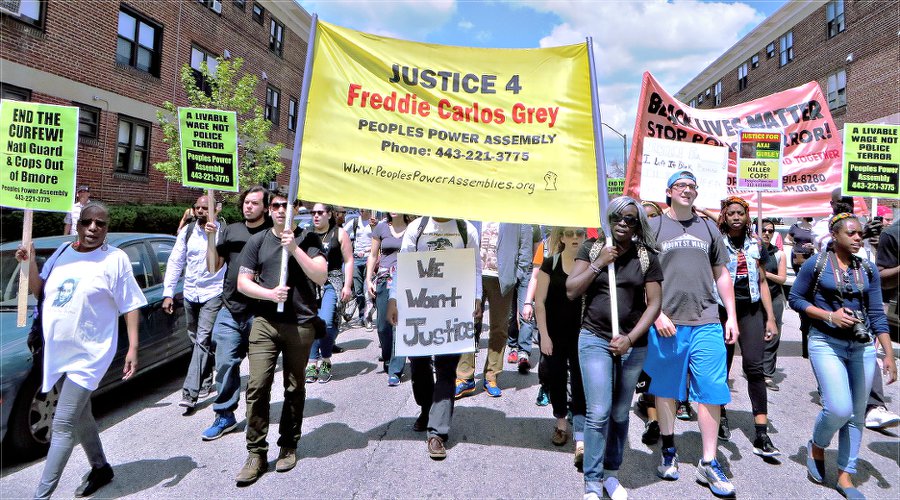

In Baltimore on May 2 protesters demanded ‘a livable wage’ as well as ‘Justice for Freddie Grey.’WW photo: Monica Moorehead
From coast to coast, momentum continues to build behind the struggle of low-wage workers fighting for $15 per hour and a union, an effort which began nearly three years ago. The week of July 20 was marked by several major victories for this movement.
On July 21, Los Angeles County approved a $15 minimum wage to be phased in by 2020. This follows in the footsteps of the city of Los Angeles, which last month passed a $15 minimum wage that will be implemented on the same time line.


In Baltimore on May 2 protesters demanded ‘a
livable wage’ as well as ‘Justice for Freddie Grey.’
WW photo: Monica Moorehead
In May, New York state Gov. Andrew Cuomo instructed the state’s Department of Labor to convene a wage board to examine wages in the fast food industry. Cuomo’s announcement came just weeks after an April 15 mobilization by low-wage workers, the largest day of action to date in the growing movement. Hundreds of thousands had hit the streets across the U.S. and in several other countries.
The day following the announcement by Los Angeles County, the New York state Wage Board concluded its hearings and issued a proposal to raise wages for fast food workers in the state to $15 per hour. This proposal, which would affect 180,000 workers in the state’s fast food industry, is expected to be enacted by Acting Labor Commissioner Mario Musolino in the coming weeks. The recommendation from the Wage Board would institute a $15 wage in New York City by 2018 and in the rest of the state by 2021.
The victory in New York state is the largest and farthest reaching to date. It follows major cities across the U.S. that have raised their minimum wage to $15 in recent months — including Seattle, San Francisco and Los Angeles. Other cities — Washington, St. Louis and others — are currently considering a $15 minimum wage. Still others have recently passed significant increases just short of $15, such as Chicago and Kansas City, Mo.
Where do we go from here?
It goes without saying that these are monumental victories that will have a dramatic impact on the lives of many working people in the U.S. These victories would not have been possible without the bravery of low-wage workers across the country who have relentlessly organized and gone on strike over the last two and a half years. All congratulations are due to them.
When this movement began in 2012, a $15 minimum wage was scoffed at by every politician and bourgeois policy pundit. Now, $15 is the baseline of every discussion on the minimum wage in the U.S.
It is an understatement to say that Cuomo and similar politicians who have passed these wage increases are no friends of working people. All of this shows that it is class struggle and the balance of power between workers and capital that is the motive force of history. We must remember that it is militant action by workers, exemplified in the strikes that low-wage workers have conducted, that made these victories possible, not the actions of politicians.
Noticeably absent, however, from these $15-minimum-wage increases is any discussion of building a union of low-wage workers. This is still a critical question for the movement. As important as these victories are, without an organization of workers to exercise power to enforce and expand upon these accomplishments, there is a very real possibility that they could be vanquished or that the bosses will find ways to undermine them.
This movement — and particularly these $15 victories — opens space to unleash a much broader, classwide struggle for not just higher wages, but power for workers in this country to take back from the banks and corporations the wealth that is being stolen from our communities every day. Think of how the struggle could reach new heights if the low-wage workers’ movement and the Black Lives Matter movement joined forces in a more substantial way.
Making central the fight against racism and police terror as part of the low-wage workers’ movement is even more critical right now. The prospect of this is terrifying to corporations, banks and the politicians who serve them in every office of government.
It seems too that, unfortunately but not surprisingly, many of the unions are reluctant to see this happen. It remains to be seen how they will summarize these recent developments and progress from here. But it will be up to the workers and the rest of the revolutionary movement in this country to help realize the potential that could be seized in this period.
The epic struggle of the Palestinian people against the full weight of U.S. imperialism and…
The following report comes from the Bronx Anti-War Coalition organizers on a protest held in…
In the Canadian federal elections held on April 28, the Liberals won with 169 seats…
The following is Part 2 of a talk given by the author to a meeting…
Boston Students, professors and workers are confronting the Trump administration’s fascist crackdown at universities across…
Philadelphia Within days of Swarthmore students reviving a pro-Palestinian encampment on April 30, police arrested…